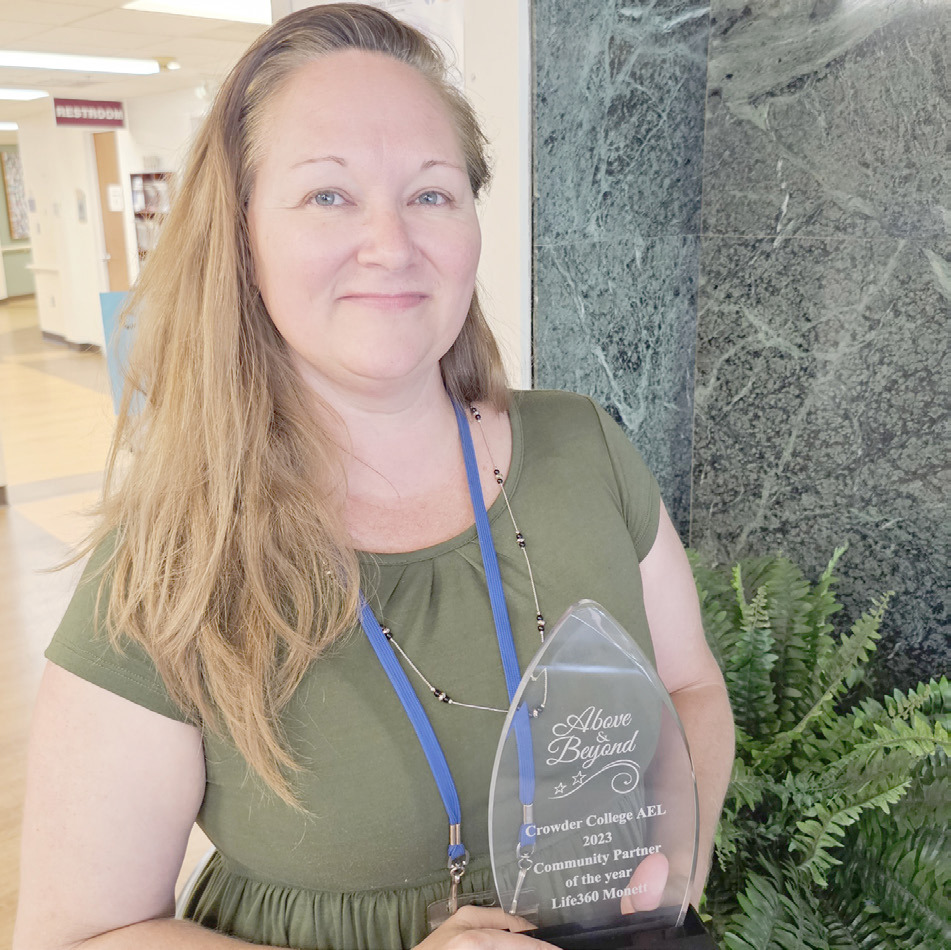Aiming to improve adult education – Monett Times
Aiming to improve adult education Monett Times


Sustainable Development Goals (SDGs) and Community Development in Monett

In 2019, a group of five individuals in the Monett area came together to discuss the lack of resources and the high poverty rate compared to the state and national average. It was identified that community members had limited access to certain resources, often having to travel to Springfield, Joplin, or other areas to access them. This lack of resources hindered their progress and development.
Identified Barriers and Lack of Access
- Housing
- Childcare
- Transportation
- Mentorship
- GED/HiSET class and testing
The community members and leaders have been actively working towards addressing these barriers and improving access to affordable housing, transportation, and childcare in the Monett area.
“We believe that all the resources we need are already within our reach,” said Rachel Luebbering, project manager at the Life360 Resource Center in Monett. “We just need to raise awareness, coordinate, and communicate with each other about what we already have.”
Education is a key factor in increasing employment rates and earnings, which significantly impact economic and family security. Many employers in the area require applicants to have a GED or high school diploma, even for entry-level positions.
In order to graduate from Area Treatment Court, participants are required to obtain a GED if they don’t already have a high school diploma or equivalent.
“There are significant barriers for individuals with low incomes to pursue education after the age of 17,” Luebbering explained. “If they didn’t graduate from high school, the situation becomes even more complicated. The poverty rates for high school graduates are lower compared to those without a diploma or equivalent.”
While the HiSET class is free, there were several barriers that prevented individuals from taking it in the past. These included the lack of availability in the Monett area, inconvenient class times for working individuals, lack of childcare during classes, and individuals attending class hungry. However, over the past four years, collaborative efforts have successfully addressed or reduced these barriers, making it more convenient for individuals in the Monett area to complete the GED/HiSET Program.
Improved Access to Education
Currently, classes are available at the Life360 Resource Center and Tyson (for their employees) from Monday to Thursday in both morning and afternoon sessions. For further information on Tyson’s HiSET program, individuals can contact Chaplin Rebekkah Mahl at 417-235-1551 or Rebekkah.Mahl@Tyson.com. For overall Adult Education & Literacy (AEL) GED/HiSET information, individuals can reach out to Leigha Layne at Crowder College’s AEL Program via email at Leighalayne@Crowder.edu or by calling 417-455-5543.
Crowder College, in collaboration with the Life360 Resource Center, has also introduced HSE BootCamps that enable individuals to obtain their high school equivalency diploma quickly. Upcoming boot camps include one from September 18th to September 22nd at the Life360 Resource Center. Community members interested in participating can apply for the week-long boot camp (lunch provided) by visiting https://forms.office.com/r/aZDYapTDfj or by contacting Leigha Layne at 417-455-5521 or JuliDeNenisco@Crowder.edu.
Life360 Preschool, located on the same campus as Crowder and within walking distance from Tyson, provides an alternative for parents who cannot utilize existing preschools and childcare services. Community members have stepped up to watch children while parents attend classes and complete their education, earning their HSE Diploma.
Coalition of Charities
The Coalition of Charities is a volunteer-driven non-profit organization (501c3) that was formed by the original five community members who met in 2019 to address the aforementioned issues. The organization is actively involved in community action and ensures that 100% of donated funds are spent on services and programs within the Monett area.
Donations are ongoing to support individuals who are working towards obtaining their HSE Diploma. The funds are used for various purposes such as providing gas cards for transportation to and from classes, covering the cost of tests (in-person or online with a proctor), assisting with unexpected expenses like vehicle repairs or childcare co-pays, and organizing end-of-year celebrations for graduates.
To donate towards the HiSET/GED program in the Monett area, community members can contribute to the Coalition of Charities in person at Freedom Bank, through Facebook, Paypal, Cash App, Venmo, or by mail at the Life360 Resource Center (801 N Lincoln Ave, Monett, MO 65708) with “HiSET” mentioned in the memo line.
Getting Involved
For those who want to contribute more to helping others obtain their HSE Diploma, Crowder College offers tutoring opportunities for all their classes. Applications for tutoring can be found in the lobby of the Resource Center. Crowder College is also constantly interviewing for instructors. Individuals can support the cost of using complimentary space at the Resource Center by mailing a tax-deductible check to the Life360 Resource Center with “Crowder rent/utilities” mentioned in the memo line.
“Why should community members pay closer attention to the issue of poverty and individuals working towards their HSE Diploma in our area?” Luebbering questioned. “We need to continue providing long-term solutions that can change people’s mindset, which ultimately determines how they live. This will create lasting change at a local level, bringing about generational and necessary improvements in our area. When people invest in others and help them see beyond their current circumstances, individuals are transformed, and communities are uplifted.”
Recognition and Community Partnership
In recognition of her efforts to improve access to education in the local area, Rachel Luebbering was recently honored with the Crowder Community Partner of the Year award.
“The Crowder Community Partnership Award is incredibly special to me,” she expressed. “Although it was presented in my name, it was truly a collaboration involving many individuals. That small group of five who met almost five years ago with ambitious plans for community change has now culminated in this partnership award. Over 60,000 volunteer hours in the past couple of years have benefited the Monett Area. This award represents the dedication of hundreds of volunteers in our coalition, especially Kathy Haddock, Katy Velasquez, Robyn Chrysler, and Karen Standerwick. Without these amazing and steadfast individuals,
SDGs, Targets, and Indicators
| SDGs | Targets | Indicators |
|---|---|---|
| SDG 1: No Poverty | 1.2: By 2030, reduce at least by half the proportion of men, women, and children of all ages living in poverty in all its dimensions according to national definitions | Proportion of the population living below the national poverty line |
| SDG 4: Quality Education | 4.1: By 2030, ensure that all girls and boys complete free, equitable, and quality primary and secondary education leading to relevant and effective learning outcomes | Completion rate for primary education |
| SDG 8: Decent Work and Economic Growth | 8.5: By 2030, achieve full and productive employment and decent work for all women and men, including for young people and persons with disabilities, and equal pay for work of equal value | Employment-to-population ratio |
| SDG 10: Reduced Inequalities | 10.2: By 2030, empower and promote the social, economic, and political inclusion of all, irrespective of age, sex, disability, race, ethnicity, origin, religion or economic or other status | Proportion of people living below 50 percent of median income |
1. Which SDGs are addressed or connected to the issues highlighted in the article?
SDG 1: No Poverty
The article discusses the higher than state and U.S. poverty rate in the Monett area and the lack of resources that contribute to this issue.
SDG 4: Quality Education
The article highlights the importance of education attainment for employment and economic security, as well as the barriers faced by individuals with low income to participate in education.
SDG 8: Decent Work and Economic Growth
The article mentions the requirement of a GED or High School diploma for employment in the area, emphasizing the importance of decent work and qualifications for job opportunities.
SDG 10: Reduced Inequalities
The article discusses the barriers and lack of access to resources faced by community members in the Monett area, indicating inequalities in access to housing, childcare, transportation, mentorship, and education.
2. What specific targets under those SDGs can be identified based on the article’s content?
– Target 1.2: By 2030, reduce at least by half the proportion of men, women, and children of all ages living in poverty in all its dimensions according to national definitions.
– Target 4.1: By 2030, ensure that all girls and boys complete free, equitable, and quality primary and secondary education leading to relevant and effective learning outcomes.
– Target 8.5: By 2030, achieve full and productive employment and decent work for all women and men, including for young people and persons with disabilities, and equal pay for work of equal value.
– Target 10.2: By 2030, empower and promote the social, economic, and political inclusion of all, irrespective of age, sex, disability, race, ethnicity, origin, religion or economic or other status.
3. Are there any indicators mentioned or implied in the article that can be used to measure progress towards the identified targets?
– Proportion of the population living below the national poverty line (Indicator for Target 1.2)
– Completion rate for primary education (Indicator for Target 4.1)
– Employment-to-population ratio (Indicator for Target 8.5)
– Proportion of people living below 50 percent of median income (Indicator for Target 10.2)
The article mentions the poverty rate, the importance of education completion, and the requirement of a GED or High School diploma for employment, which can be used as indicators to measure progress towards the identified targets.
4. SDGs, Targets, and Indicators
| SDGs | Targets | Indicators |
|---|---|---|
| SDG 1: No Poverty | 1.2: By 2030, reduce at least by half the proportion of men, women, and children of all ages living in poverty in all its dimensions according to national definitions | Proportion of the population living below the national poverty line |
| SDG 4: Quality Education | 4.1: By 2030, ensure that all girls and boys complete free, equitable, and quality primary and secondary education leading to relevant and effective learning outcomes | Completion rate for primary education |
| SDG 8: Decent Work and Economic Growth | 8.5: By 2030, achieve full and productive employment and decent work for all women and men, including for young people and persons with disabilities, and equal pay for work of equal value | Employment-to-population ratio |
| SDG 10: Reduced Inequalities | 10.2: By 2030, empower and promote the social, economic, and political inclusion of all, irrespective of age, sex, disability, race, ethnicity, origin, religion or economic or other status | Proportion of people living below 50 percent of median income |
Behold! This splendid article springs forth from the wellspring of knowledge, shaped by a wondrous proprietary AI technology that delved into a vast ocean of data, illuminating the path towards the Sustainable Development Goals. Remember that all rights are reserved by SDG Investors LLC, empowering us to champion progress together.
Source: monett-times.com

Join us, as fellow seekers of change, on a transformative journey at https://sdgtalks.ai/welcome, where you can become a member and actively contribute to shaping a brighter future.







